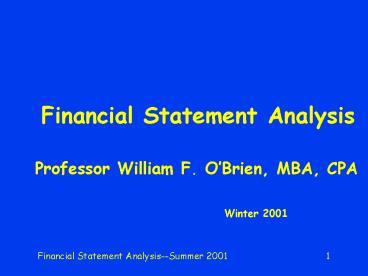Financial Statement Analysis PowerPoint PPT Presentation
1 / 22
Title: Financial Statement Analysis
1
Financial Statement Analysis
- Professor William F. OBrien, MBA, CPA
Winter 2001
2
The 3 Ps
- Preparation
- Processing
- Presentation
3
Reasons for Analysis
- Investment decisions
- Credit decisions
- Performance
- Valuation (investment)
- Legal liability amount (credit perf.)
- Going concern decisions (credit perf.)
- Unreasonable returns (performance)
4
FSA Steps
- Identify the economic characteristics
- Identify the corporate strategies
- Understand the financial statements
- Assess the profitability and risk
- Value the particular firm
5
Tools for Economic Analysis
- Value Chain Analysis
- Porters Five Forces
- Economic Attributes Framework
6
Porters Five Forces
- Buyer Power
- Supplier Power
- Rivalry among Firms
- Threat of New Entrants
- Threat of Substitutes
7
Economic Attributes Framework
- Demand
- price sensitivity
- demand growth
- cyclical demand
- seasonal demand
- Supply
- number of suppliers
- barriers to entry
- Manufacturing
- capital intensity
- process complexity
- Marketing
- marketing channel--corporate or consumer
- demand pull or demand creation
- Financing
- Nature of assets
- Asset risk
- Source of cash flow--internal or external
8
Strategic Analysis Framework
- Nature of product or service
- Degree of Integration
- Degree of Geographical Diversification
- Degree of Industry Diversification
9
Financial Statements
- Balance Sheet
- Income Statement
- Statement of Cash Flows
- Footnotes
- Auditors Report
- Management Discussion and Analysis
10
Income Statement Classification
- Operating income
- Other income and expense
- Income from continuing operations
- Income, gains losses from discontinued
operations - Extraordinary gains and losses
- Changes in accounting principles
11
Comprehensive Income
- Net income plus or minus the changes in
shareholders equity from other than net income
or transactions with owners.
12
Other F/S Considerations
- Quality of Earnings
- Statement of Cash Flows
- Auditors Report
13
Tools of Profit and Risk Analysis
- Common Size Financial Statements
- Percentage Change Statements
- Comparative Analysis
- Critical Financial Ratios
14
Risks of Comparative Analysis
- Timing
- GAAP Application
- Degree of Conservatism
- Management Attitude
- Size
- Geographic Diversification
15
Critical Financial Ratios
- Profitability Ratios
- EPS
- ROCE
- Risk Ratios
- Current ratio
- CFO/Avg. Current Liabilities
- Debt/Equity
16
Valuation
- Price-Earnings Ratio
- Market value to Book value Ratio
17
Role of FSA in Capital Markets
- One View FSA has no impact
- The Other View
- FSA is a catalyst
- FSA identifies individual opportunities
- Equity markets are not perfectly eff.
- FSA cleanses F/S biases
- FSA has unique purpose itself
18
Sources of Information
- Annual Report
- Form 10-K
- Form 10-Q
- Form 8-K
- Prospectus
- Form 20-F (foreign entity 10-K)
19
Statement of Cash Flows
- FASB 95--1987
- Components
- Operating cash Operations and working capital
- Investing cash Non-current assets and
investments - Financing cash L/T debt, equity and dividends
20
Businesses are like Fruit Trees
Fruit Operating Activities
Trunk Branches Investing Activities
Roots Financing Activities
21
Net Income vs. Cash FlowIndirect Method
- Net Income
- /- Non-cash Items
- /- Changes in Operating Working Capital
- Cash Flow from Operations
22
Indirect vs. Direct Method
- FASB prefers the direct method
- FASB requires net income to cash from operations
reconciliation - Components
- Cash from customers
- Cash from dividends
- Cash from interest income
- Other operating cash receipts
- Cash paid to suppliers
- Cash paid to employees
- Cash paid for taxes
- Cash paid for interest
- Other operating cash payments

